Wireless Communication: WSN-GSM Bushfire Monitoring System Report
VerifiedAdded on 2023/06/05
|24
|5204
|198
Report
AI Summary
This report presents a wireless sensor network (WSN) designed for bushfire monitoring, utilizing GSM technology for communication. The system employs temperature and humidity sensors connected to a microcontroller, which interfaces with a GPS receiver and GSM module to transmit sensory data. The report justifies the use of WSN due to its wide applicability and GSM technology for its cost-effectiveness, global deployment, and high transmission quality. It reviews existing bushfire monitoring systems, including word-of-mouth, watch-towers, aerial monitoring, and satellite-based systems, highlighting their limitations in terms of reliability, cost, and complexity. The proposed WSN-based system aims to address these shortcomings by offering a cost-effective and efficient solution for early bushfire detection and alarm dissemination. The report outlines the system's architecture, feasibility, and potential benefits for forest management and natural risk mitigation.
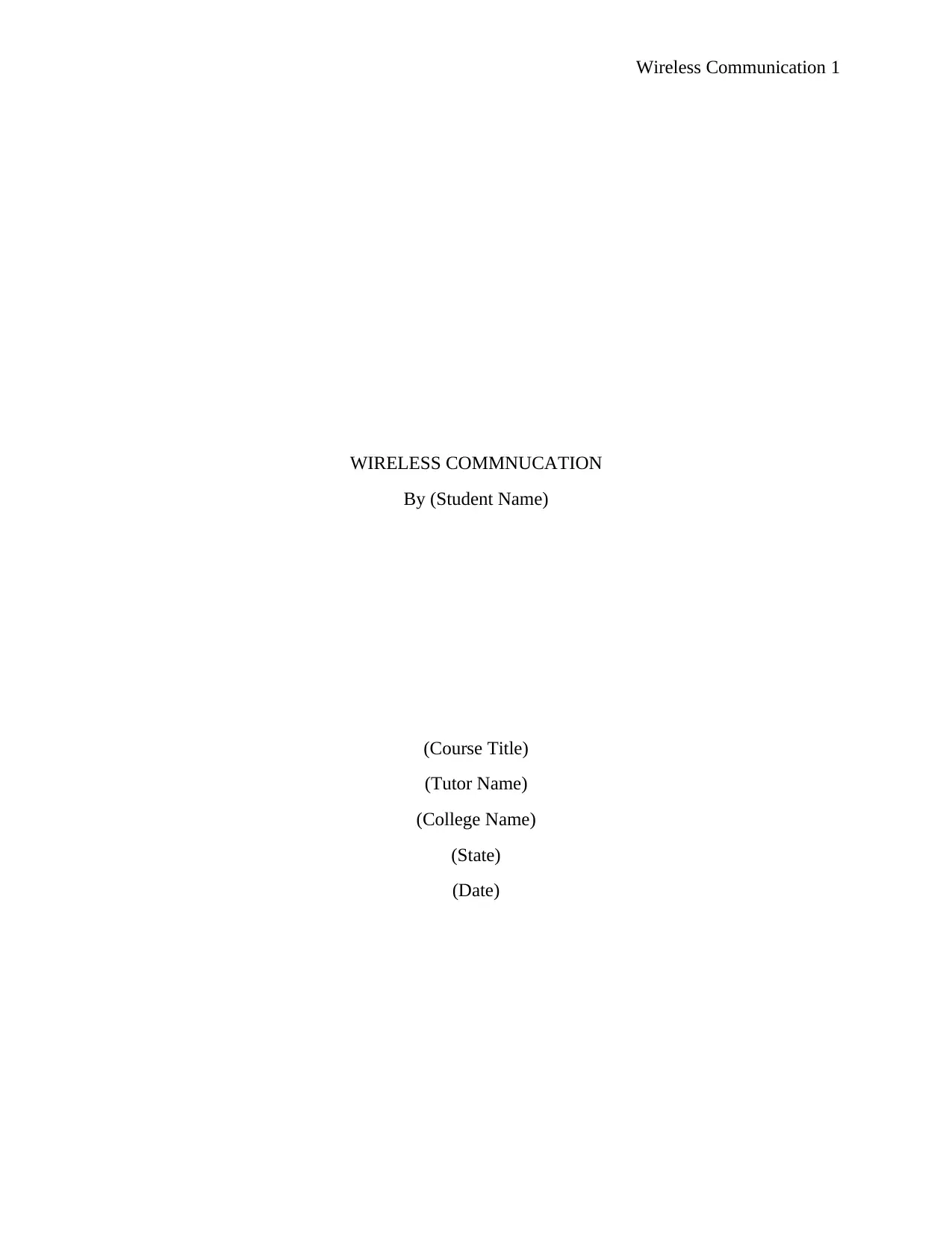
Wireless Communication 1
WIRELESS COMMNUCATION
By (Student Name)
(Course Title)
(Tutor Name)
(College Name)
(State)
(Date)
WIRELESS COMMNUCATION
By (Student Name)
(Course Title)
(Tutor Name)
(College Name)
(State)
(Date)
Paraphrase This Document
Need a fresh take? Get an instant paraphrase of this document with our AI Paraphraser

Wireless Communication 2
Executive summary
Wireless sensor network widely known as WSN consists of disseminated independent
gadget which use sensors to monitor the physical environment. The system integrates a firewall
that provides wireless connectivity back to the wide area network. This project paper describes
into detail smart bush fire system which can be used to provide a warmly warning message in
times of bushfire. The system utilizes GSM type of technology. The technology is used as a
medium of communication. The bushfire system is composed of humidity and temperature
sensors which are connected via a microcontroller.
Justification
To start with, this project utilizes WSN; this is because WSN has been used a lot by lots
of applications. For example in health in monitoring nuclear power plants and guiding other
applications. This project utilizes GSM technology. One of the reasons as to why this project
utilized this type of technology is because it provides cost-effective solutions and products. In
addition, to this GSM technology has been deployed heavily across the world this means that
phone works across the globe hence WSN-bushfire monitoring system will have no difficult
during the implantation phase in any country. This also leverage costs benefits and it also
provides seamless wireless connectivity. It will also help in availing the voice and data services
without any disruption. GSM technology also provides very high transmission quality. Lastly,
by utilizing GSM technology is that it provides a wide coverage; according to GSM Company
has coordinated its spectrum meaning which even though lots of nations might be operating on a
dissimilar frequency bands users can transfer effortlessly among different networks and same at
a time keep the same number. The technology also operates in a variety of phones; this means
that the users are flexible in choosing a handset of their choice.
Executive summary
Wireless sensor network widely known as WSN consists of disseminated independent
gadget which use sensors to monitor the physical environment. The system integrates a firewall
that provides wireless connectivity back to the wide area network. This project paper describes
into detail smart bush fire system which can be used to provide a warmly warning message in
times of bushfire. The system utilizes GSM type of technology. The technology is used as a
medium of communication. The bushfire system is composed of humidity and temperature
sensors which are connected via a microcontroller.
Justification
To start with, this project utilizes WSN; this is because WSN has been used a lot by lots
of applications. For example in health in monitoring nuclear power plants and guiding other
applications. This project utilizes GSM technology. One of the reasons as to why this project
utilized this type of technology is because it provides cost-effective solutions and products. In
addition, to this GSM technology has been deployed heavily across the world this means that
phone works across the globe hence WSN-bushfire monitoring system will have no difficult
during the implantation phase in any country. This also leverage costs benefits and it also
provides seamless wireless connectivity. It will also help in availing the voice and data services
without any disruption. GSM technology also provides very high transmission quality. Lastly,
by utilizing GSM technology is that it provides a wide coverage; according to GSM Company
has coordinated its spectrum meaning which even though lots of nations might be operating on a
dissimilar frequency bands users can transfer effortlessly among different networks and same at
a time keep the same number. The technology also operates in a variety of phones; this means
that the users are flexible in choosing a handset of their choice.
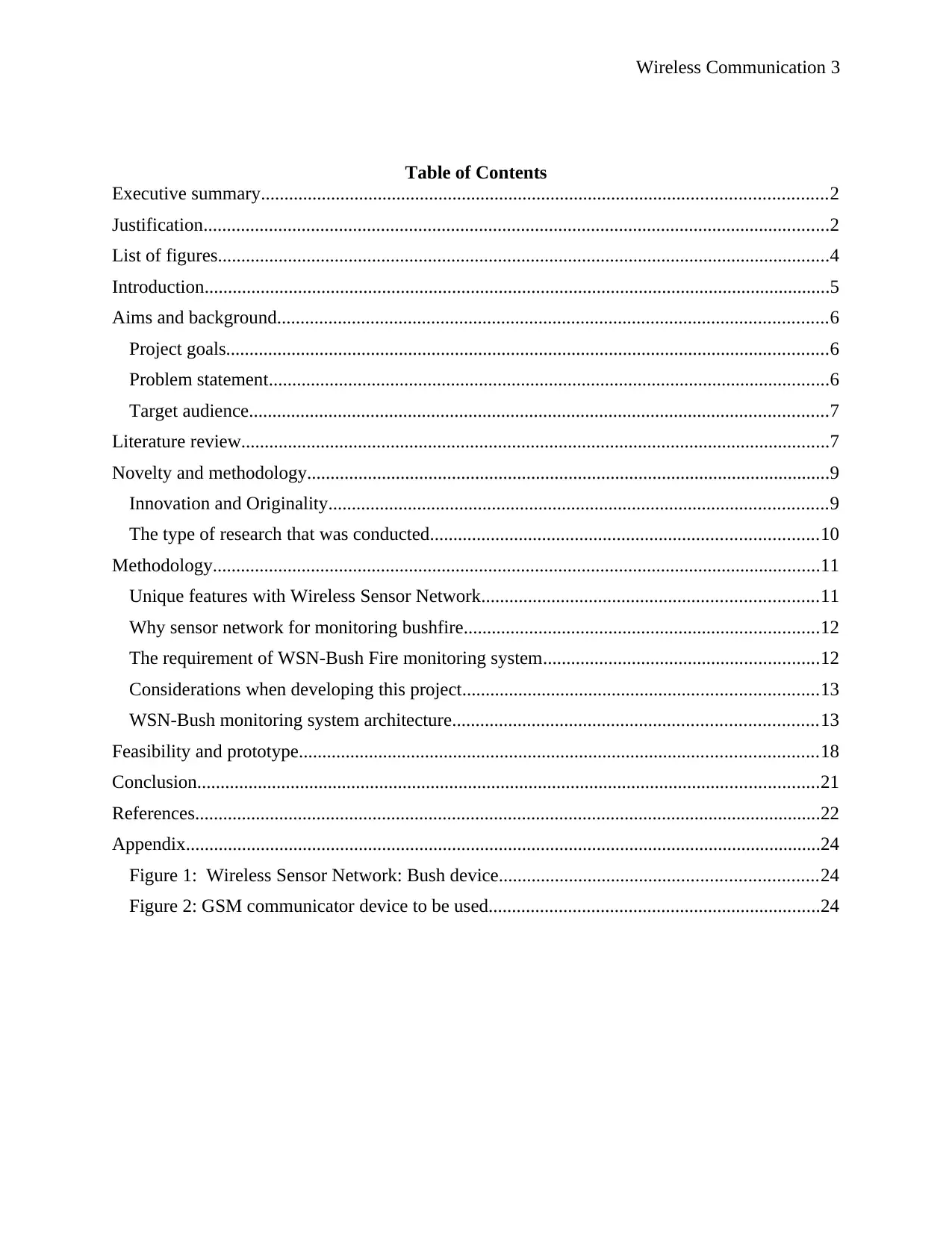
Wireless Communication 3
Table of Contents
Executive summary.........................................................................................................................2
Justification......................................................................................................................................2
List of figures...................................................................................................................................4
Introduction......................................................................................................................................5
Aims and background......................................................................................................................6
Project goals.................................................................................................................................6
Problem statement........................................................................................................................6
Target audience............................................................................................................................7
Literature review..............................................................................................................................7
Novelty and methodology................................................................................................................9
Innovation and Originality...........................................................................................................9
The type of research that was conducted...................................................................................10
Methodology..................................................................................................................................11
Unique features with Wireless Sensor Network........................................................................11
Why sensor network for monitoring bushfire............................................................................12
The requirement of WSN-Bush Fire monitoring system...........................................................12
Considerations when developing this project............................................................................13
WSN-Bush monitoring system architecture..............................................................................13
Feasibility and prototype...............................................................................................................18
Conclusion.....................................................................................................................................21
References......................................................................................................................................22
Appendix........................................................................................................................................24
Figure 1: Wireless Sensor Network: Bush device....................................................................24
Figure 2: GSM communicator device to be used.......................................................................24
Table of Contents
Executive summary.........................................................................................................................2
Justification......................................................................................................................................2
List of figures...................................................................................................................................4
Introduction......................................................................................................................................5
Aims and background......................................................................................................................6
Project goals.................................................................................................................................6
Problem statement........................................................................................................................6
Target audience............................................................................................................................7
Literature review..............................................................................................................................7
Novelty and methodology................................................................................................................9
Innovation and Originality...........................................................................................................9
The type of research that was conducted...................................................................................10
Methodology..................................................................................................................................11
Unique features with Wireless Sensor Network........................................................................11
Why sensor network for monitoring bushfire............................................................................12
The requirement of WSN-Bush Fire monitoring system...........................................................12
Considerations when developing this project............................................................................13
WSN-Bush monitoring system architecture..............................................................................13
Feasibility and prototype...............................................................................................................18
Conclusion.....................................................................................................................................21
References......................................................................................................................................22
Appendix........................................................................................................................................24
Figure 1: Wireless Sensor Network: Bush device....................................................................24
Figure 2: GSM communicator device to be used.......................................................................24
⊘ This is a preview!⊘
Do you want full access?
Subscribe today to unlock all pages.

Trusted by 1+ million students worldwide
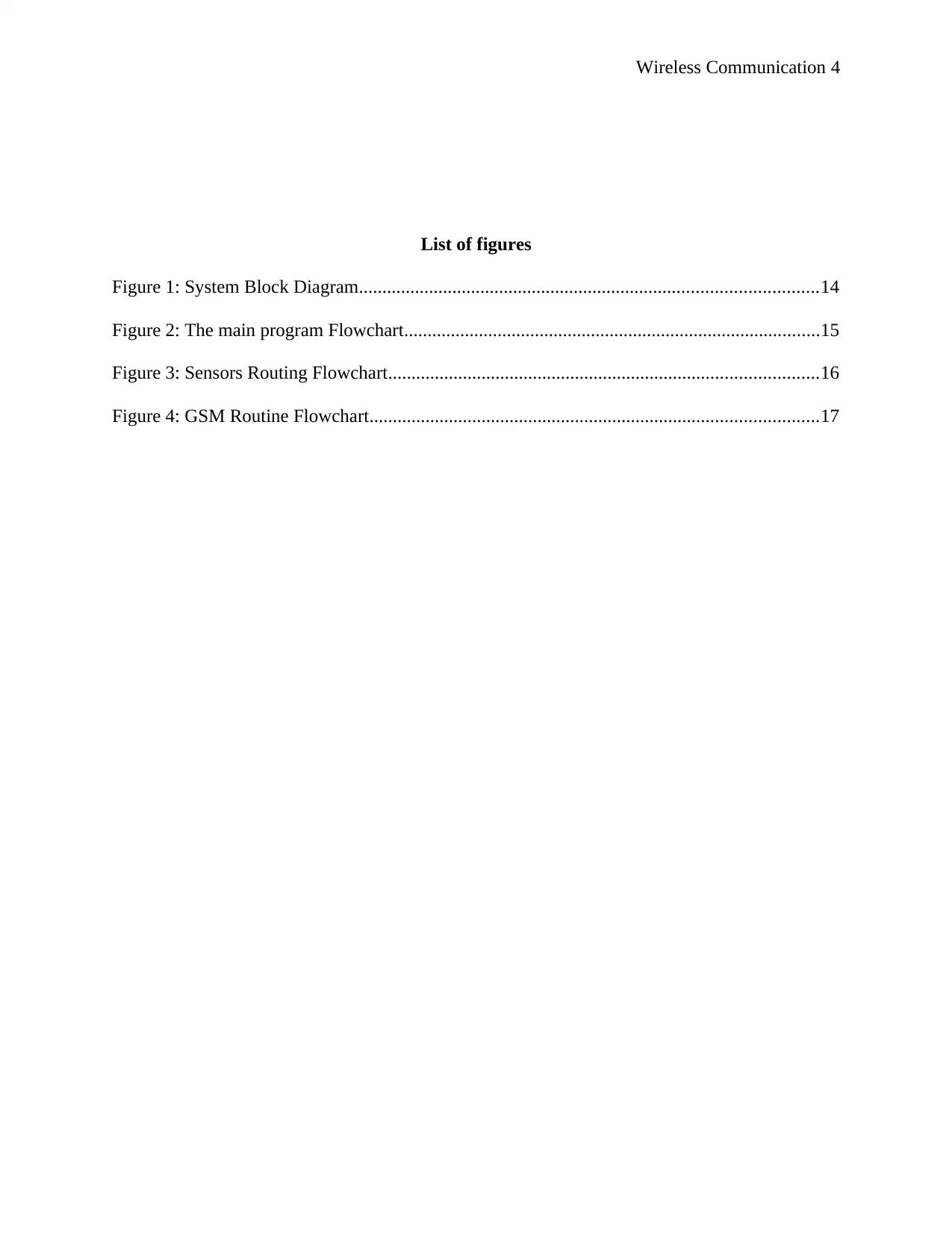
Wireless Communication 4
List of figures
Figure 1: System Block Diagram..................................................................................................14
Figure 2: The main program Flowchart.........................................................................................15
Figure 3: Sensors Routing Flowchart............................................................................................16
Figure 4: GSM Routine Flowchart................................................................................................17
List of figures
Figure 1: System Block Diagram..................................................................................................14
Figure 2: The main program Flowchart.........................................................................................15
Figure 3: Sensors Routing Flowchart............................................................................................16
Figure 4: GSM Routine Flowchart................................................................................................17
Paraphrase This Document
Need a fresh take? Get an instant paraphrase of this document with our AI Paraphraser
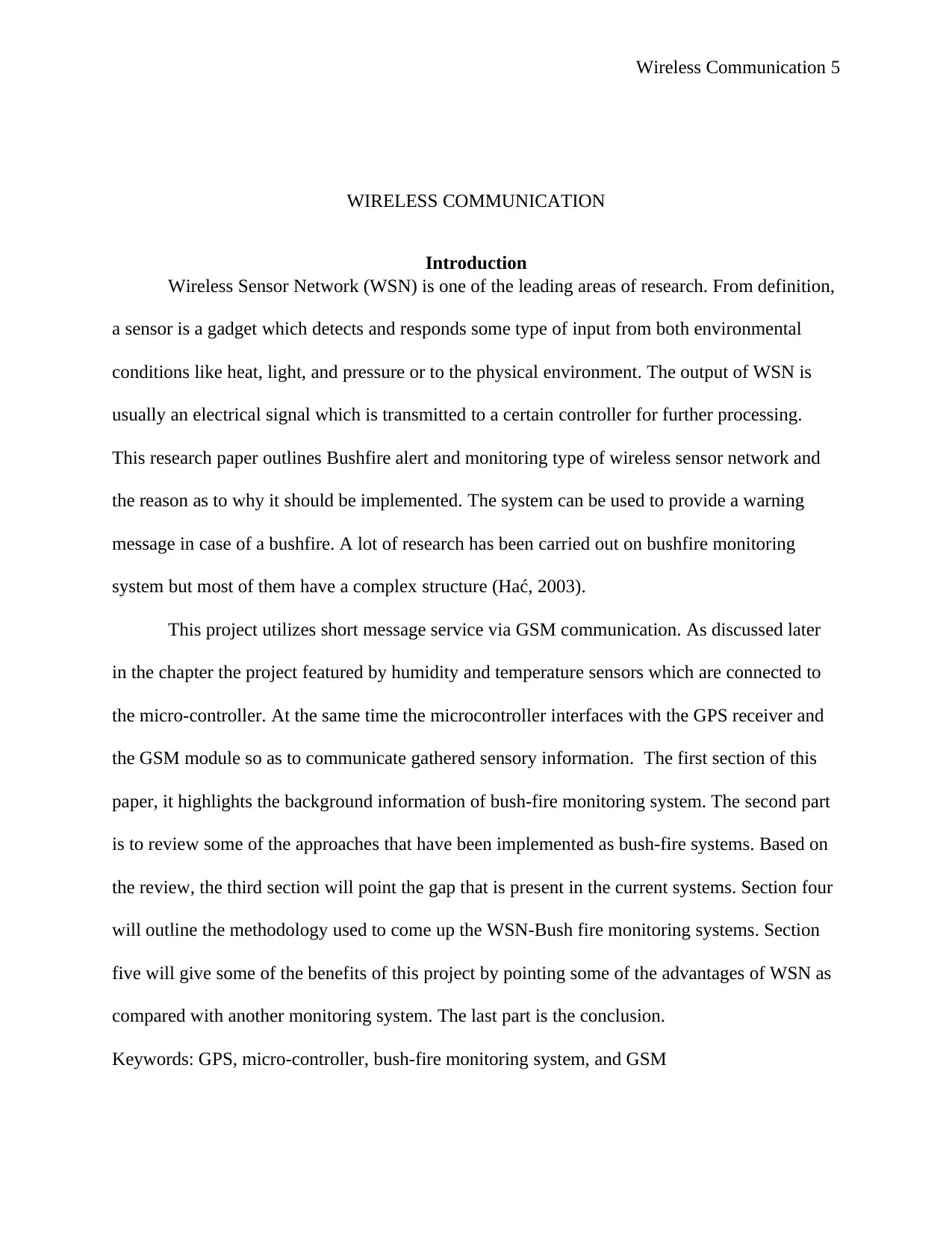
Wireless Communication 5
WIRELESS COMMUNICATION
Introduction
Wireless Sensor Network (WSN) is one of the leading areas of research. From definition,
a sensor is a gadget which detects and responds some type of input from both environmental
conditions like heat, light, and pressure or to the physical environment. The output of WSN is
usually an electrical signal which is transmitted to a certain controller for further processing.
This research paper outlines Bushfire alert and monitoring type of wireless sensor network and
the reason as to why it should be implemented. The system can be used to provide a warning
message in case of a bushfire. A lot of research has been carried out on bushfire monitoring
system but most of them have a complex structure (Hać, 2003) .
This project utilizes short message service via GSM communication. As discussed later
in the chapter the project featured by humidity and temperature sensors which are connected to
the micro-controller. At the same time the microcontroller interfaces with the GPS receiver and
the GSM module so as to communicate gathered sensory information. The first section of this
paper, it highlights the background information of bush-fire monitoring system. The second part
is to review some of the approaches that have been implemented as bush-fire systems. Based on
the review, the third section will point the gap that is present in the current systems. Section four
will outline the methodology used to come up the WSN-Bush fire monitoring systems. Section
five will give some of the benefits of this project by pointing some of the advantages of WSN as
compared with another monitoring system. The last part is the conclusion.
Keywords: GPS, micro-controller, bush-fire monitoring system, and GSM
WIRELESS COMMUNICATION
Introduction
Wireless Sensor Network (WSN) is one of the leading areas of research. From definition,
a sensor is a gadget which detects and responds some type of input from both environmental
conditions like heat, light, and pressure or to the physical environment. The output of WSN is
usually an electrical signal which is transmitted to a certain controller for further processing.
This research paper outlines Bushfire alert and monitoring type of wireless sensor network and
the reason as to why it should be implemented. The system can be used to provide a warning
message in case of a bushfire. A lot of research has been carried out on bushfire monitoring
system but most of them have a complex structure (Hać, 2003) .
This project utilizes short message service via GSM communication. As discussed later
in the chapter the project featured by humidity and temperature sensors which are connected to
the micro-controller. At the same time the microcontroller interfaces with the GPS receiver and
the GSM module so as to communicate gathered sensory information. The first section of this
paper, it highlights the background information of bush-fire monitoring system. The second part
is to review some of the approaches that have been implemented as bush-fire systems. Based on
the review, the third section will point the gap that is present in the current systems. Section four
will outline the methodology used to come up the WSN-Bush fire monitoring systems. Section
five will give some of the benefits of this project by pointing some of the advantages of WSN as
compared with another monitoring system. The last part is the conclusion.
Keywords: GPS, micro-controller, bush-fire monitoring system, and GSM

Wireless Communication 6
Aims and background
Project goals
The overall objective for this project is to support a forest management via the prevention
of bushfires. This is done by applying a set of measures by implementing efficient bushfire
monitoring system. The strategic objective of this project is mitigation and prevention of natural
risks with a special focus on the bushfires.
WSN-Bush fire monitoring system aims at using wireless sensors to monitor forest for
the risk of fire and maybe extreme weather conditions. WSN is a type of network which is
composed of a large number of sensors which are deployed to monitor the environment via
wireless communication. The sensors nodes rely on a battery power supply and their
communication (Akyildiz, 2011).
The current systems such as word-of-mouth, watch-towers, and aerial monitoring systems
are not efficient and reliable. In addition, the satellite monitoring system is very complex and
requires a very high cost to install.
This proposed project aims at increasing efficiency and on time delivery of alarm
message to the relevant fire authorities. The project also aims at reducing the current high cost of
installing bush fire systems and the high cost of maintenance.
Problem statement
As we all know bushfire is one of serious national disaster around the world. Effects of
Bushfires have been reported by various organizations one of them being the United Nations; the
organization has done several publications on bushfire effects. Bushfire as highlighted by the UN
usually starts during summer seasons which results in a huge loss of life and destruction of
property. It results in environmental damage and wildlife.
Aims and background
Project goals
The overall objective for this project is to support a forest management via the prevention
of bushfires. This is done by applying a set of measures by implementing efficient bushfire
monitoring system. The strategic objective of this project is mitigation and prevention of natural
risks with a special focus on the bushfires.
WSN-Bush fire monitoring system aims at using wireless sensors to monitor forest for
the risk of fire and maybe extreme weather conditions. WSN is a type of network which is
composed of a large number of sensors which are deployed to monitor the environment via
wireless communication. The sensors nodes rely on a battery power supply and their
communication (Akyildiz, 2011).
The current systems such as word-of-mouth, watch-towers, and aerial monitoring systems
are not efficient and reliable. In addition, the satellite monitoring system is very complex and
requires a very high cost to install.
This proposed project aims at increasing efficiency and on time delivery of alarm
message to the relevant fire authorities. The project also aims at reducing the current high cost of
installing bush fire systems and the high cost of maintenance.
Problem statement
As we all know bushfire is one of serious national disaster around the world. Effects of
Bushfires have been reported by various organizations one of them being the United Nations; the
organization has done several publications on bushfire effects. Bushfire as highlighted by the UN
usually starts during summer seasons which results in a huge loss of life and destruction of
property. It results in environmental damage and wildlife.
⊘ This is a preview!⊘
Do you want full access?
Subscribe today to unlock all pages.

Trusted by 1+ million students worldwide
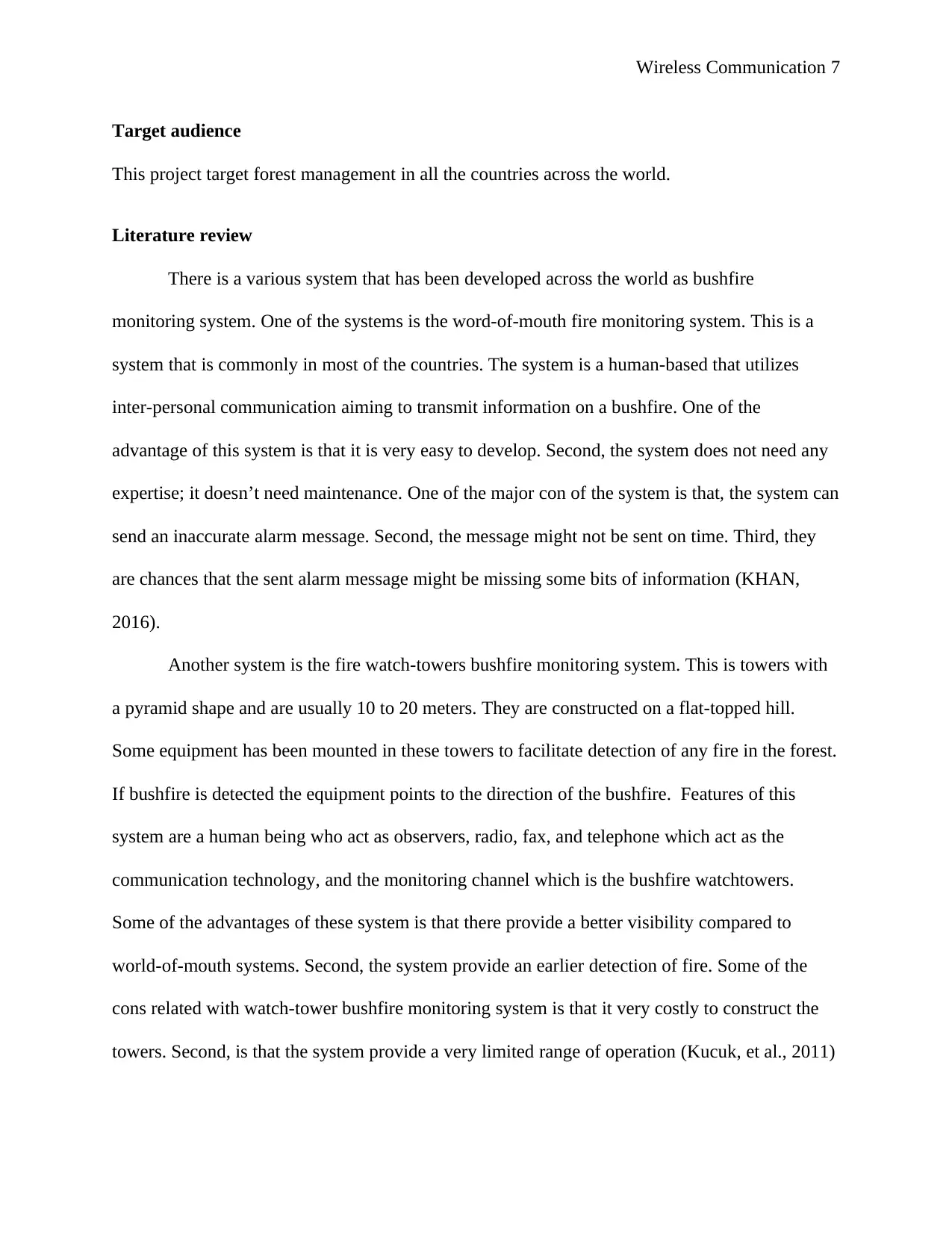
Wireless Communication 7
Target audience
This project target forest management in all the countries across the world.
Literature review
There is a various system that has been developed across the world as bushfire
monitoring system. One of the systems is the word-of-mouth fire monitoring system. This is a
system that is commonly in most of the countries. The system is a human-based that utilizes
inter-personal communication aiming to transmit information on a bushfire. One of the
advantage of this system is that it is very easy to develop. Second, the system does not need any
expertise; it doesn’t need maintenance. One of the major con of the system is that, the system can
send an inaccurate alarm message. Second, the message might not be sent on time. Third, they
are chances that the sent alarm message might be missing some bits of information (KHAN,
2016).
Another system is the fire watch-towers bushfire monitoring system. This is towers with
a pyramid shape and are usually 10 to 20 meters. They are constructed on a flat-topped hill.
Some equipment has been mounted in these towers to facilitate detection of any fire in the forest.
If bushfire is detected the equipment points to the direction of the bushfire. Features of this
system are a human being who act as observers, radio, fax, and telephone which act as the
communication technology, and the monitoring channel which is the bushfire watchtowers.
Some of the advantages of these system is that there provide a better visibility compared to
world-of-mouth systems. Second, the system provide an earlier detection of fire. Some of the
cons related with watch-tower bushfire monitoring system is that it very costly to construct the
towers. Second, is that the system provide a very limited range of operation (Kucuk, et al., 2011)
Target audience
This project target forest management in all the countries across the world.
Literature review
There is a various system that has been developed across the world as bushfire
monitoring system. One of the systems is the word-of-mouth fire monitoring system. This is a
system that is commonly in most of the countries. The system is a human-based that utilizes
inter-personal communication aiming to transmit information on a bushfire. One of the
advantage of this system is that it is very easy to develop. Second, the system does not need any
expertise; it doesn’t need maintenance. One of the major con of the system is that, the system can
send an inaccurate alarm message. Second, the message might not be sent on time. Third, they
are chances that the sent alarm message might be missing some bits of information (KHAN,
2016).
Another system is the fire watch-towers bushfire monitoring system. This is towers with
a pyramid shape and are usually 10 to 20 meters. They are constructed on a flat-topped hill.
Some equipment has been mounted in these towers to facilitate detection of any fire in the forest.
If bushfire is detected the equipment points to the direction of the bushfire. Features of this
system are a human being who act as observers, radio, fax, and telephone which act as the
communication technology, and the monitoring channel which is the bushfire watchtowers.
Some of the advantages of these system is that there provide a better visibility compared to
world-of-mouth systems. Second, the system provide an earlier detection of fire. Some of the
cons related with watch-tower bushfire monitoring system is that it very costly to construct the
towers. Second, is that the system provide a very limited range of operation (Kucuk, et al., 2011)
Paraphrase This Document
Need a fresh take? Get an instant paraphrase of this document with our AI Paraphraser

Wireless Communication 8
Aerial and ground monitoring bushfire monitoring system is a type of system which
utilizes temporary fireguards and ground patrolling for fire detection, control, and protection.
The system also utilizes aircraft bushfire over the air and sends an alarm message if it’s
observed. The system works by first observing a fire via air of through ground men. The report is
the transmitted through the telephone to the relevant authorities. The system has three major
features which are patrol craft and ground men who are the monitoring channel. The
communication medium is the observers, and the communication channel is through the radio.
One of the advantages of this system is that aerial patrolling can detect a wider range as
compared to the previous two systems. Some of the disadvantages of the system is that it is very
expensive as it utilizes aerial patrolling. Second, an alarm message to the relevant authorities
might not be sent in time (Farrugia, 2011)
The most recent system is the satellite-based bush fire system. This is a system that
utilizes satellite which consists of a communication network and a satellite. The satellite
component is used to monitor the forest from space via an embedded sensor network, in case of
any fire, the satellite component activates sirens which sends a warning message which travels
through the communication network component. Some of the features of this type of system are
a satellite with a sensor network, sea receiver station, an aircraft receiver, and a satellite-
commuter link. One of the major advantage with these type of system an improved reliability as
compared with the previous three systems. The systems are able to send alarm message in time
and it relies on accurate information related to bushfire. Some of the disadvantages are that it is
complicated and it requires a high maintenance and establishment cost (Fujimoto, 2008).
Aerial and ground monitoring bushfire monitoring system is a type of system which
utilizes temporary fireguards and ground patrolling for fire detection, control, and protection.
The system also utilizes aircraft bushfire over the air and sends an alarm message if it’s
observed. The system works by first observing a fire via air of through ground men. The report is
the transmitted through the telephone to the relevant authorities. The system has three major
features which are patrol craft and ground men who are the monitoring channel. The
communication medium is the observers, and the communication channel is through the radio.
One of the advantages of this system is that aerial patrolling can detect a wider range as
compared to the previous two systems. Some of the disadvantages of the system is that it is very
expensive as it utilizes aerial patrolling. Second, an alarm message to the relevant authorities
might not be sent in time (Farrugia, 2011)
The most recent system is the satellite-based bush fire system. This is a system that
utilizes satellite which consists of a communication network and a satellite. The satellite
component is used to monitor the forest from space via an embedded sensor network, in case of
any fire, the satellite component activates sirens which sends a warning message which travels
through the communication network component. Some of the features of this type of system are
a satellite with a sensor network, sea receiver station, an aircraft receiver, and a satellite-
commuter link. One of the major advantage with these type of system an improved reliability as
compared with the previous three systems. The systems are able to send alarm message in time
and it relies on accurate information related to bushfire. Some of the disadvantages are that it is
complicated and it requires a high maintenance and establishment cost (Fujimoto, 2008).
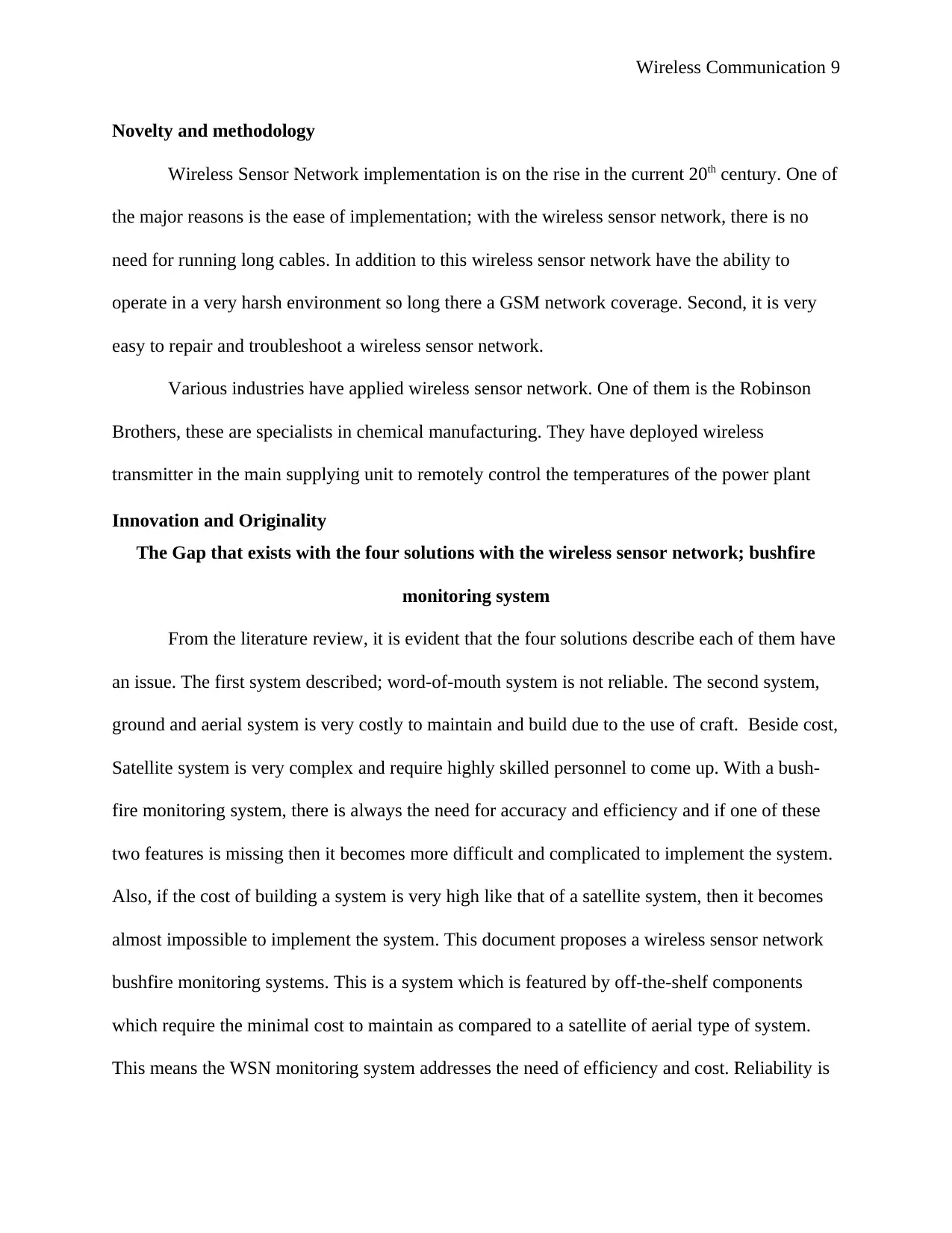
Wireless Communication 9
Novelty and methodology
Wireless Sensor Network implementation is on the rise in the current 20th century. One of
the major reasons is the ease of implementation; with the wireless sensor network, there is no
need for running long cables. In addition to this wireless sensor network have the ability to
operate in a very harsh environment so long there a GSM network coverage. Second, it is very
easy to repair and troubleshoot a wireless sensor network.
Various industries have applied wireless sensor network. One of them is the Robinson
Brothers, these are specialists in chemical manufacturing. They have deployed wireless
transmitter in the main supplying unit to remotely control the temperatures of the power plant
Innovation and Originality
The Gap that exists with the four solutions with the wireless sensor network; bushfire
monitoring system
From the literature review, it is evident that the four solutions describe each of them have
an issue. The first system described; word-of-mouth system is not reliable. The second system,
ground and aerial system is very costly to maintain and build due to the use of craft. Beside cost,
Satellite system is very complex and require highly skilled personnel to come up. With a bush-
fire monitoring system, there is always the need for accuracy and efficiency and if one of these
two features is missing then it becomes more difficult and complicated to implement the system.
Also, if the cost of building a system is very high like that of a satellite system, then it becomes
almost impossible to implement the system. This document proposes a wireless sensor network
bushfire monitoring systems. This is a system which is featured by off-the-shelf components
which require the minimal cost to maintain as compared to a satellite of aerial type of system.
This means the WSN monitoring system addresses the need of efficiency and cost. Reliability is
Novelty and methodology
Wireless Sensor Network implementation is on the rise in the current 20th century. One of
the major reasons is the ease of implementation; with the wireless sensor network, there is no
need for running long cables. In addition to this wireless sensor network have the ability to
operate in a very harsh environment so long there a GSM network coverage. Second, it is very
easy to repair and troubleshoot a wireless sensor network.
Various industries have applied wireless sensor network. One of them is the Robinson
Brothers, these are specialists in chemical manufacturing. They have deployed wireless
transmitter in the main supplying unit to remotely control the temperatures of the power plant
Innovation and Originality
The Gap that exists with the four solutions with the wireless sensor network; bushfire
monitoring system
From the literature review, it is evident that the four solutions describe each of them have
an issue. The first system described; word-of-mouth system is not reliable. The second system,
ground and aerial system is very costly to maintain and build due to the use of craft. Beside cost,
Satellite system is very complex and require highly skilled personnel to come up. With a bush-
fire monitoring system, there is always the need for accuracy and efficiency and if one of these
two features is missing then it becomes more difficult and complicated to implement the system.
Also, if the cost of building a system is very high like that of a satellite system, then it becomes
almost impossible to implement the system. This document proposes a wireless sensor network
bushfire monitoring systems. This is a system which is featured by off-the-shelf components
which require the minimal cost to maintain as compared to a satellite of aerial type of system.
This means the WSN monitoring system addresses the need of efficiency and cost. Reliability is
⊘ This is a preview!⊘
Do you want full access?
Subscribe today to unlock all pages.

Trusted by 1+ million students worldwide

Wireless Communication 10
also one of the issues addressed by the system. The system can detect fire and send an alarm
message on time.
The type of research that was conducted
This is the scientific type of research which is a qualitative one. The project aims at
gaining insights into the issues faced by the current monitoring system. The research outlines
give a justification as to why organizations and countries need to adopt WSN systems in
monitoring bushfires. The research also uncovers some of the trends that are used in satellite
monitoring systems. First, this project seeks to formulate a question that is there a need of new
bush monitoring systems due to the destruction of the environment and the ineffectiveness of the
current systems in play. The project proceeds to systematically use a set of procedures to answer
the question by giving a solution of wireless sensor network systems. The project adopted this
type of research due to the ability of qualitative research in providing textual descriptions of
WSN-bush monitoring systems (Berg, 2015).
One of the advantages of this type of research is its opened nature. It allows the project to
flexibility probe the current systems used monitoring bushfires. Second, the subject material
which is bushfire monitoring is evaluated with an in-depth detail; since the goal of this project is
to provide efficient, low cost, and reliable fire monitoring systems, qualitative type of research
helps in creating measurable outcomes. Third, since it is not based on data, the qualitative
research helps in creating industry-specific insights thus giving a chance to creativity and
innovation (Lewis, 2015).
also one of the issues addressed by the system. The system can detect fire and send an alarm
message on time.
The type of research that was conducted
This is the scientific type of research which is a qualitative one. The project aims at
gaining insights into the issues faced by the current monitoring system. The research outlines
give a justification as to why organizations and countries need to adopt WSN systems in
monitoring bushfires. The research also uncovers some of the trends that are used in satellite
monitoring systems. First, this project seeks to formulate a question that is there a need of new
bush monitoring systems due to the destruction of the environment and the ineffectiveness of the
current systems in play. The project proceeds to systematically use a set of procedures to answer
the question by giving a solution of wireless sensor network systems. The project adopted this
type of research due to the ability of qualitative research in providing textual descriptions of
WSN-bush monitoring systems (Berg, 2015).
One of the advantages of this type of research is its opened nature. It allows the project to
flexibility probe the current systems used monitoring bushfires. Second, the subject material
which is bushfire monitoring is evaluated with an in-depth detail; since the goal of this project is
to provide efficient, low cost, and reliable fire monitoring systems, qualitative type of research
helps in creating measurable outcomes. Third, since it is not based on data, the qualitative
research helps in creating industry-specific insights thus giving a chance to creativity and
innovation (Lewis, 2015).
Paraphrase This Document
Need a fresh take? Get an instant paraphrase of this document with our AI Paraphraser
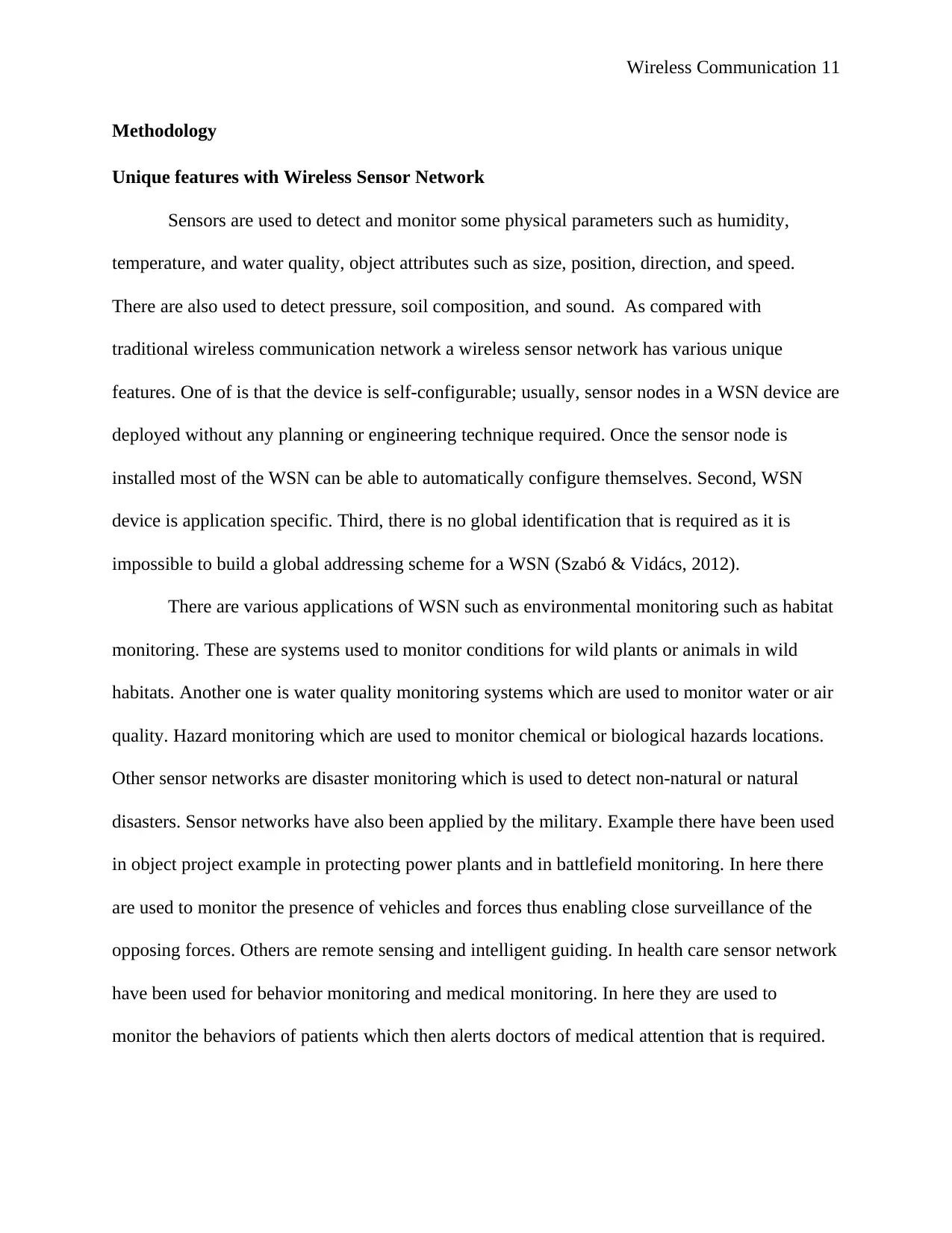
Wireless Communication 11
Methodology
Unique features with Wireless Sensor Network
Sensors are used to detect and monitor some physical parameters such as humidity,
temperature, and water quality, object attributes such as size, position, direction, and speed.
There are also used to detect pressure, soil composition, and sound. As compared with
traditional wireless communication network a wireless sensor network has various unique
features. One of is that the device is self-configurable; usually, sensor nodes in a WSN device are
deployed without any planning or engineering technique required. Once the sensor node is
installed most of the WSN can be able to automatically configure themselves. Second, WSN
device is application specific. Third, there is no global identification that is required as it is
impossible to build a global addressing scheme for a WSN (Szabó & Vidács, 2012) .
There are various applications of WSN such as environmental monitoring such as habitat
monitoring. These are systems used to monitor conditions for wild plants or animals in wild
habitats. Another one is water quality monitoring systems which are used to monitor water or air
quality. Hazard monitoring which are used to monitor chemical or biological hazards locations.
Other sensor networks are disaster monitoring which is used to detect non-natural or natural
disasters. Sensor networks have also been applied by the military. Example there have been used
in object project example in protecting power plants and in battlefield monitoring. In here there
are used to monitor the presence of vehicles and forces thus enabling close surveillance of the
opposing forces. Others are remote sensing and intelligent guiding. In health care sensor network
have been used for behavior monitoring and medical monitoring. In here they are used to
monitor the behaviors of patients which then alerts doctors of medical attention that is required.
Methodology
Unique features with Wireless Sensor Network
Sensors are used to detect and monitor some physical parameters such as humidity,
temperature, and water quality, object attributes such as size, position, direction, and speed.
There are also used to detect pressure, soil composition, and sound. As compared with
traditional wireless communication network a wireless sensor network has various unique
features. One of is that the device is self-configurable; usually, sensor nodes in a WSN device are
deployed without any planning or engineering technique required. Once the sensor node is
installed most of the WSN can be able to automatically configure themselves. Second, WSN
device is application specific. Third, there is no global identification that is required as it is
impossible to build a global addressing scheme for a WSN (Szabó & Vidács, 2012) .
There are various applications of WSN such as environmental monitoring such as habitat
monitoring. These are systems used to monitor conditions for wild plants or animals in wild
habitats. Another one is water quality monitoring systems which are used to monitor water or air
quality. Hazard monitoring which are used to monitor chemical or biological hazards locations.
Other sensor networks are disaster monitoring which is used to detect non-natural or natural
disasters. Sensor networks have also been applied by the military. Example there have been used
in object project example in protecting power plants and in battlefield monitoring. In here there
are used to monitor the presence of vehicles and forces thus enabling close surveillance of the
opposing forces. Others are remote sensing and intelligent guiding. In health care sensor network
have been used for behavior monitoring and medical monitoring. In here they are used to
monitor the behaviors of patients which then alerts doctors of medical attention that is required.
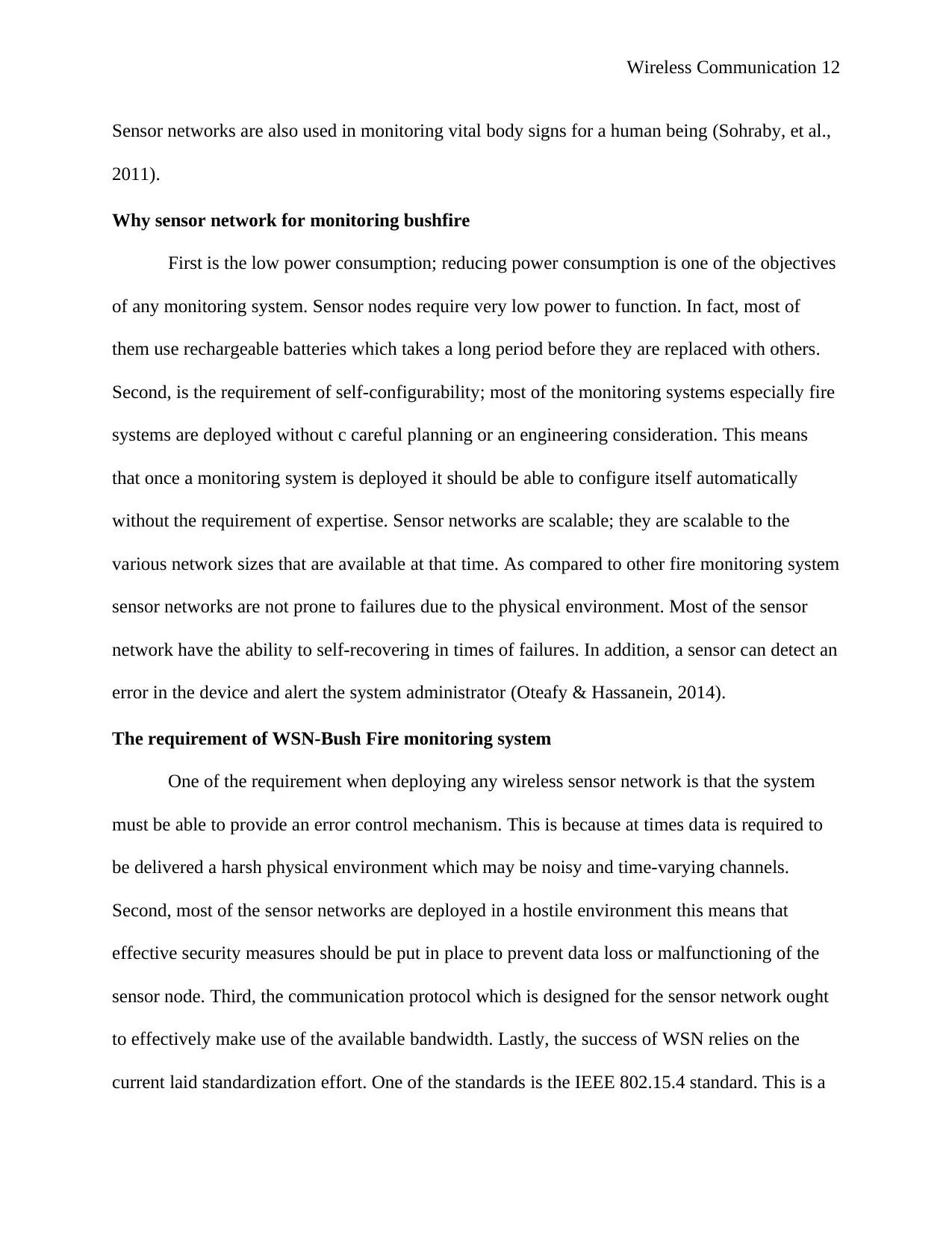
Wireless Communication 12
Sensor networks are also used in monitoring vital body signs for a human being (Sohraby, et al.,
2011).
Why sensor network for monitoring bushfire
First is the low power consumption; reducing power consumption is one of the objectives
of any monitoring system. Sensor nodes require very low power to function. In fact, most of
them use rechargeable batteries which takes a long period before they are replaced with others.
Second, is the requirement of self-configurability; most of the monitoring systems especially fire
systems are deployed without c careful planning or an engineering consideration. This means
that once a monitoring system is deployed it should be able to configure itself automatically
without the requirement of expertise. Sensor networks are scalable; they are scalable to the
various network sizes that are available at that time. As compared to other fire monitoring system
sensor networks are not prone to failures due to the physical environment. Most of the sensor
network have the ability to self-recovering in times of failures. In addition, a sensor can detect an
error in the device and alert the system administrator (Oteafy & Hassanein, 2014).
The requirement of WSN-Bush Fire monitoring system
One of the requirement when deploying any wireless sensor network is that the system
must be able to provide an error control mechanism. This is because at times data is required to
be delivered a harsh physical environment which may be noisy and time-varying channels.
Second, most of the sensor networks are deployed in a hostile environment this means that
effective security measures should be put in place to prevent data loss or malfunctioning of the
sensor node. Third, the communication protocol which is designed for the sensor network ought
to effectively make use of the available bandwidth. Lastly, the success of WSN relies on the
current laid standardization effort. One of the standards is the IEEE 802.15.4 standard. This is a
Sensor networks are also used in monitoring vital body signs for a human being (Sohraby, et al.,
2011).
Why sensor network for monitoring bushfire
First is the low power consumption; reducing power consumption is one of the objectives
of any monitoring system. Sensor nodes require very low power to function. In fact, most of
them use rechargeable batteries which takes a long period before they are replaced with others.
Second, is the requirement of self-configurability; most of the monitoring systems especially fire
systems are deployed without c careful planning or an engineering consideration. This means
that once a monitoring system is deployed it should be able to configure itself automatically
without the requirement of expertise. Sensor networks are scalable; they are scalable to the
various network sizes that are available at that time. As compared to other fire monitoring system
sensor networks are not prone to failures due to the physical environment. Most of the sensor
network have the ability to self-recovering in times of failures. In addition, a sensor can detect an
error in the device and alert the system administrator (Oteafy & Hassanein, 2014).
The requirement of WSN-Bush Fire monitoring system
One of the requirement when deploying any wireless sensor network is that the system
must be able to provide an error control mechanism. This is because at times data is required to
be delivered a harsh physical environment which may be noisy and time-varying channels.
Second, most of the sensor networks are deployed in a hostile environment this means that
effective security measures should be put in place to prevent data loss or malfunctioning of the
sensor node. Third, the communication protocol which is designed for the sensor network ought
to effectively make use of the available bandwidth. Lastly, the success of WSN relies on the
current laid standardization effort. One of the standards is the IEEE 802.15.4 standard. This is a
⊘ This is a preview!⊘
Do you want full access?
Subscribe today to unlock all pages.

Trusted by 1+ million students worldwide
1 out of 24
Related Documents
Your All-in-One AI-Powered Toolkit for Academic Success.
+13062052269
info@desklib.com
Available 24*7 on WhatsApp / Email
![[object Object]](/_next/static/media/star-bottom.7253800d.svg)
Unlock your academic potential
Copyright © 2020–2025 A2Z Services. All Rights Reserved. Developed and managed by ZUCOL.





